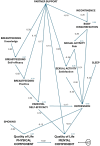Analysis of variables affecting postpartum quality of life: their relative influence and interrelationships
- PMID: 40604467
- PMCID: PMC12218815
- DOI: 10.1186/s12884-025-07803-w
Analysis of variables affecting postpartum quality of life: their relative influence and interrelationships
Abstract
Background: The postpartum period is a time of special vulnerability and unacceptably high morbidity for the mother, which warrants in-depth study. The objective of this study is to analyze the variables affecting quality of life (QoL) during the first six months postpartum, their relative influence, and the relationships between them.
Methods: Cross-sectional study with the participation of 289 postpartum women, who answered the digital questionnaires: SF-12 for QoL; EMAeHealth for self-management of health in the postpartum, which assesses: incontinence, sexuality, breastfeeding, adaptation to the maternal role and mental health; and "Prescribe Healthy Life" Screening Questionnaire, which measures diet, exercise and consumption of toxic. To analyze the relationship between the variables and their relative influence on QoL, a structural equation model was built.
Results: Depression (β=-0.640; 90%CI: (-0.670)-(-0.505); p = 0.006), partner support (β = 0.331; 90%CI:0.217-0.424; p = 0.003), parental self-efficacy (β = 0.219; 90%CI:0.134-0.309; p = 0.001) and physical QoL (β=-0.223; 90%CI: (-0.294)-(-0.142); p = 0.002) are related to the mental dimension of QoL. Partner support also influences the breastfeeding self-efficacy (β = 0.28; 90%CI:0.197-0.373; p = 0.002), sexual satisfaction (β = 0.48; 90%CI:0.38-0.56; p = 0.03), body dissatisfaction (β=-0.155; 90%CI: (-0.27)-(-0.04); p = 0.031), and parental self-efficacy (β = 0.170; 90%CI:0.027-0.344; p = 0.045), which indirectly affect QoL. Depressive symptoms (β=-0.126; 90%CI: (-0.218)-(-0.026); p = 0.044) and smoking (β=-0.224; 90%CI: (-0.314)-(-0.132); p = 0.002) affect the physical component of QoL.
Conclusions: This study explains the influence of the variables involved in QoL after childbirth and their interrelationship, providing a graphical representation that facilitates a comprehensive understanding. This knowledge forces us, as midwives, to review perinatal and postpartum care with the aim of paying special attention to partner support and depressive symptoms.
Keywords: Mental quality of life; Physical quality of life; Postpartum; Quality of life.
© 2025. The Author(s).
Conflict of interest statement
Declarations. Ethics approval and consent to participate: The Basque Clinical Ethics Committee (file number PI2019110) approved the study in accordance with the relevant guidelines and regulations. Prior to participating in the study, all the participating women were informed of the study and an informed consent was provided by all the participants for this study. The consent and information sheet had been previously approved by the Ethics Committee. This study was conducted in compliance with the Declaration of Helsinki, which governs research involving human subjects and/or the use of human data. Consent for publication: Not applicable. Competing interests: The authors declare no competing interests.
Figures
Similar articles
-
The Relationship of Postpartum Depression With Breastfeeding Self-Efficacy and Perceived Social Support in the Postpartum Period: A Sample From an Obstetrics-Gynaecology and Paediatrics Hospital.Scand J Caring Sci. 2025 Sep;39(3):e70050. doi: 10.1111/scs.70050. Scand J Caring Sci. 2025. PMID: 40605407
-
Impact of medical school on quality of life and mental health in Brazil: a cross-sectional comparative study.BMJ Open. 2025 Jun 4;15(6):e097917. doi: 10.1136/bmjopen-2024-097917. BMJ Open. 2025. PMID: 40467311 Free PMC article.
-
Pregnancy variables that impact postpartum quality of life: a multicenter prospective study.Sci Rep. 2025 Aug 25;15(1):31294. doi: 10.1038/s41598-025-10699-3. Sci Rep. 2025. PMID: 40855091 Free PMC article.
-
Exercise interventions and patient beliefs for people with hip, knee or hip and knee osteoarthritis: a mixed methods review.Cochrane Database Syst Rev. 2018 Apr 17;4(4):CD010842. doi: 10.1002/14651858.CD010842.pub2. Cochrane Database Syst Rev. 2018. PMID: 29664187 Free PMC article.
-
Oral non-steroidal anti-inflammatory drugs (single dose) for perineal pain in the early postpartum period.Cochrane Database Syst Rev. 2016 Jul 14;7(7):CD011352. doi: 10.1002/14651858.CD011352.pub2. Cochrane Database Syst Rev. 2016. Update in: Cochrane Database Syst Rev. 2021 Jan 11;1:CD011352. doi: 10.1002/14651858.CD011352.pub3. PMID: 27412362 Free PMC article. Updated.
References
-
- Sheikh J, Allotey J, Kew T, et al. Vulnerabilities and reparative strategies during pregnancy, childbirth, and the postpartum period: moving from rhetoric to action. The lancet series, maternal health in the perinatal period and beyond 2. eClinicalMedicine. 2024;67:102264. 10.1016/j.eclinm.2023.10226. - PMC - PubMed
-
- Souza JP, Day LT, Rezende-Gomes AC, et al. A global analysis of the determinants of maternal health and transitions in maternal mortality. The lancet series, maternal health in the perinatal period and beyond 1. Lancet Glob Health. 2024;12:e306–16. 10.1016/S2214-109X(23)00468-0. - PubMed
MeSH terms
Grants and funding
LinkOut - more resources
Full Text Sources
Medical


